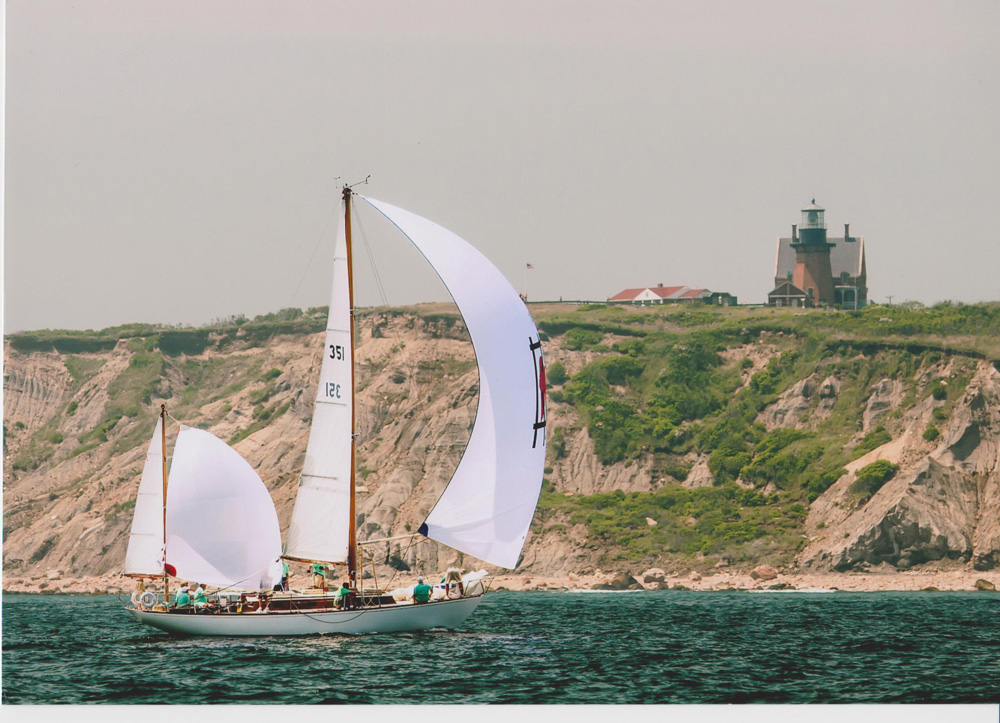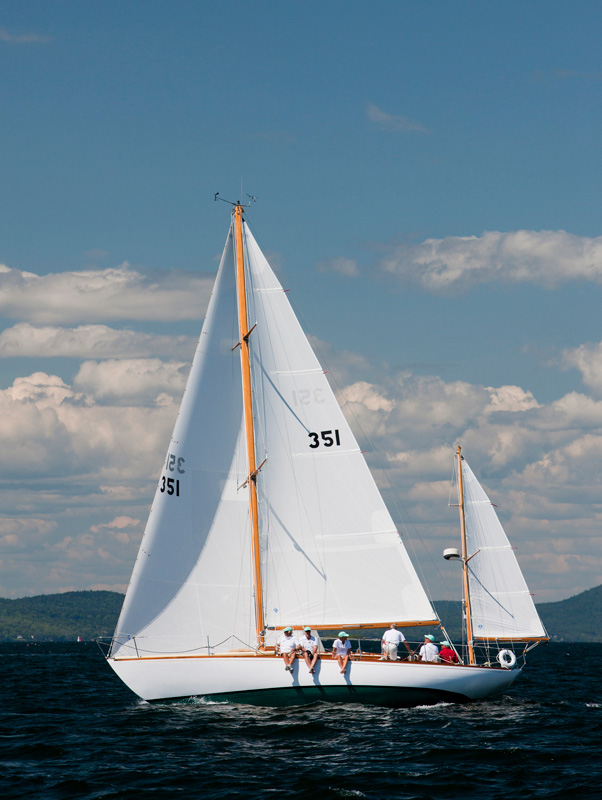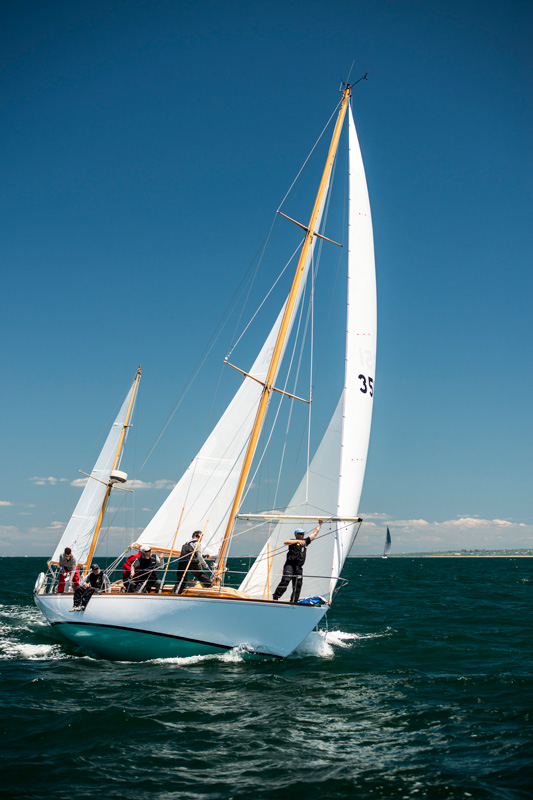In Part I, we introduced the “S & S Twins,” my name for the two Olin Stephens 39-foot designs, Finisterre and Fidelio. This month, we put into perspective what was so unique about this Sparkman & Stephens design, and what the meticulously maintained sistership is doing on her Maine home waters.
Finisterre was the most famous offshore design of the 1950s, Carleton Mitchell’s S & S equivalent of what Dorade and Stormy Weather were to the young Olin Stephens in the 1930s. Launched in 1954, Finisterre was not Mitchell’s first boat. In fact, she was his third sailboat. A converted Alden schooner, Carib, was his first magic carpet for the Antilles, and she was followed by a larger Rhodes design. But to do his dream boat, “Mitch” wanted only Olin. Unfortunately, Olin Stephens had designed Finisterre too late for the biennial Newport Bermuda Race of 1954. In 1956, she broke the mold cast in the 1930s. Bermuda Race 1956: overall winner.
The longtime editor of Yachting, Bill Robinson listed many reasons for Finisterre’s success ranging from Mitchell’s knowledge of weather to winches, but he did not connect the centerboard dots as a reason for her success. Even so, retracting foils help a vessel to surf or plane. Finisterre was able to surf the storm fronts owing to her centerboard, thereby bettering her betters. This theory of the centerboarder was to dominate auxiliary sailboat design for a generation, yielding to the spade rudder and fin keel of the Cal 40 in the 1970s. She was greatly imitated by other builders and these imitations led to rule changes tending to reduce the success of her type.
One of the most iconic designers of the last 40-plus years, Rod Johnstone knows something about breakthrough boats like Finisterre, beginning with the J/24 in 1979. Rod grew up in Stonington, CT with a harborful of centerboard derivatives from the Finisterre lines. The 24-foot Dolphin, built first by George O’Day, is a miniature Finisterre. “We sailed all kinds of centerboard boats,” Rod recalls, and I loved that Marionette (the Dolphin). Rod in fact five years ago designed his own, the J/95, after sailing a variety of centerboard designs like the C & C Corvette.

Fidelio powers past Block Island’s Southeast Light. Photo courtesy of Carol Connor
Rod puts the Finisterre design in perspective and points out that in fact a centerboard boat was at its best in big wind and rough water. He has a highly technical but plausible rationale for the power of the centerboard: it lowers the inertia and hence the hobby-horsing of a design upwind in a breeze. This is classic Rod Johnstone. To hear more of his comments, visit my Conversations with Classic Boats podcast for The S & S Twins (Episode 05) at conversationswithclassicboats.com.
The record speaks for itself. Finisterre was arguably the top racing sailboat of the 20th century. Finisterre was first in class and first overall in three consecutive Bermuda Races (1956, ‘58, and ‘60), a feat never equaled since. Think of winning the baseball Triple Crown three seasons in a row, winning three Boston Marathons in a row, or winning Wimbledon three times in a row.
The third race, the 1960 Bermuda Race, started in light air but is memorable for its Force8/9 gale with hurricane force gusts recorded. Many boats went into survival mode, hove to, laying a hull with bare poles or running off dragging lines astern. Through it all, Finisterre carried sail and never stopped racing under her #3 jib, deeply reefed main and full mizzen with sheets eased slightly to keep moving through heavy seas. She had many other racing successes offshore, notably in the SORC in 1957 and 1958 when she won the Miami-Nassau Race both years. This rather small, 39-foot LOA, beamy, bronze centerboard yawl combined speed – especially in light air – seaworthiness and comfort, in a great racing boat in all conditions.
Even with that racing pedigree, Carleton Mitchell was proudest of his boat as cruiser: “It was as a cruising boat that I felt Finisterre was truly a success,” he wrote. “She was comfortable, easy to sail shorthanded, and her shallow draft makes gunkholing possible.”
My Rhode Island sailing family of six stuffed into 30ish-foot boats in the 1960s. We sailed in boats of this legacy, moderate displacement, centerboard designs, great for the shoal patches, of a Waquoit Bay, for the shifting sands of Menemsha Pond, for crossing the bars on Nantucket Sound, or tucking into shoal corners of Great Salt Pond, the centerboard was a bit of magic, taking you where others couldn’t go.
Postscript to Finisterre
The next time a traditional-shaped fiberglass boat won the Newport Bermuda Race would be in 2014 – 60 years after the birth of Finisterre – when the Bermuda 40, the old, slightly sharpened Finisterre shape, was the winner of the St. David’s Lighthouse Division. The boat was Actea, another S & S design, owned by Connie & Mike Cone.
Fidelio: CYOA Star
I have to thank one of my podcast audience for turning my attention to Cousin Fidelio. The Connors from Noank, CT, Carol Connor in particular, called me after my first podcast on the Newport 29 Dolphin and told me about Fidelio. Carol sent me a photo of her off the Southeast Light corner of Block Island – stunning with all five sails flying. I had to pursue this story.
Fidelio’s owner was Charles T. Townsend, who everyone calls “Chuck.” I was fortunate to find Chuck battening down the hatches of his Vero Beach, FL home in advance of yet another 2020 season hurricane by the name of ETA. On the subject of Fidelio, it was clear we could have talked for hours.

Chuck Townsend and his crew raced Fidelio very successfully for eleven seasons.
© Billy Black/billyblack.com
Chuck’s story of how he got to sailing is remarkably like that of Carlton Mitchell’s. Fresh out of school in Michigan, the college grad went south in search of something to do. What he found was the beginning of Bertram Yachts under the leadership of their colorful leader, Dick Bertram, in the old South Florida of boatbuilding and smuggling. The coincidence is that Dick Bertram, the S & S of offshore motorboat racing and the champion of Ray Hunt’s deep V hull shape, was a great buddy of Carleton Mitchell, who was Bertram’s wingman and his navigator in powerboat races to Nassau. Mitchell made the move to power early. In fact, in his later cruising years, it was Mitchell who championed the trawler style as the ultimately motor cruising design. That raffish Miami boating crowd was Chuck’s introduction to yachting’s colorful characters.
Fidelio’s birthplace was 4,000 miles away from Finisterre’s birthplace at the Peterson yard in Old Saybrook, CT. It was the German yard next to the famed Abeking & Rasmussen yard in Hamburg in cold, dark, wet Northern Germany, but with a great nautical heritage. Fidelio was constructed with an extraordinary internal bronze space frame, reminiscent of the internal grid frames of Scandinavian and German designs of today. In every other respect, she was Finisterre’s twin.
Fidelio had four owners before Chuck, but nobody seems to remember who they were. Chuck’s story is that of an experienced yachtsman who saw his dream boat on the mooring in Maine and bought her on the spot. Chuck’s account of how he acquired the boat has a Walter Mitty ring.
“We were in Maine on a New York Yacht Club cruise and we took the motorboat out,” Chuck recalls. “We saw her at the mooring, chubby but beautiful lines, those gorgeous S & S lines. Turns out she was for sale. I said to everybody, ‘I am going to buy that boat,’ and that fall I did. I bought Fidelio because I fell in love with her. And we had a ball with her.”
Carol Connor was part of the core crew family that went everywhere for over a decade. Her husband, Paul, was the main trimmer and she, the navigator and tactician, had the nickname “Queen of the Cockpit.” Fidelio is well known as one of the most consistent boats on the Classic Yacht Owners Association CRF (Classic Rating Formula) circuit, with piles of hardware to show for it.
There have been some wild rides and some close calls. Carol Connor gives us the story of a Mr. Toad’s Wild Ride down the backside of Block Island during a Race Week Around the Island Race. On board was Tom Whidden from North Sails, another regular Fidelio crew member. Carol recalls blowing out two chutes on their way to a third-place finish in 30 knots plus. “No problem,” Whidden said. “North will make you more spinnakers.” That’s the spirit, learned from coaching Connors in Noank and a certain Conner in San Diego.
From 2008 to 2019, Fidelio was a happy ship with a loyal crew. Finally in 2019 the crew totted up their sailing injuries and Chuck decided to sell Fidelio.
It finally meant finding her a new hope for life after 63. The old girl was ready for boating Social Security.

Fidelio shows off her lovely lines at Block Island Race Week.
© Allen Clark/PhotoBoat.com
What has happened to these two, the S & S Cousins? Where did they end up in their senior days, ages 66 and 64 respectively, in 2020? Finisterre one can only really follow through online brokerage ads in Southern Europe on the Med. The lady has been neglected; passed along like an old rusting car in a New England family. I know how hard it is to keep wooden boats up in any climate. She’s been many colors. She needs some surgery. She’s drooping at the back. How ironic that the apple of the eye of a famous blue water sailor would live out her senior days being passed in Euros from one set of hands to the other –the famous athlete whose prime time is past.
In the meantime, Fidelio passed to a new owner, a gentleman sailor in Castine, ME. Good hands, Chuck felt. But New Owner didn’t want the container of racing sails. “I won’t be needing them,” said New Owner. That’s classic spirit.
So, if you’re in Maine or the Med this season, keep your eyes open for the S & S Twins. ■
Tom Darling organizes Team Dolphin for its annual Opera House Cup sail, and sails Alerions in Nantucket Harbor. You’ll find his Conversations with Classic Boats podcast at conversationswithclassicboats.com.




